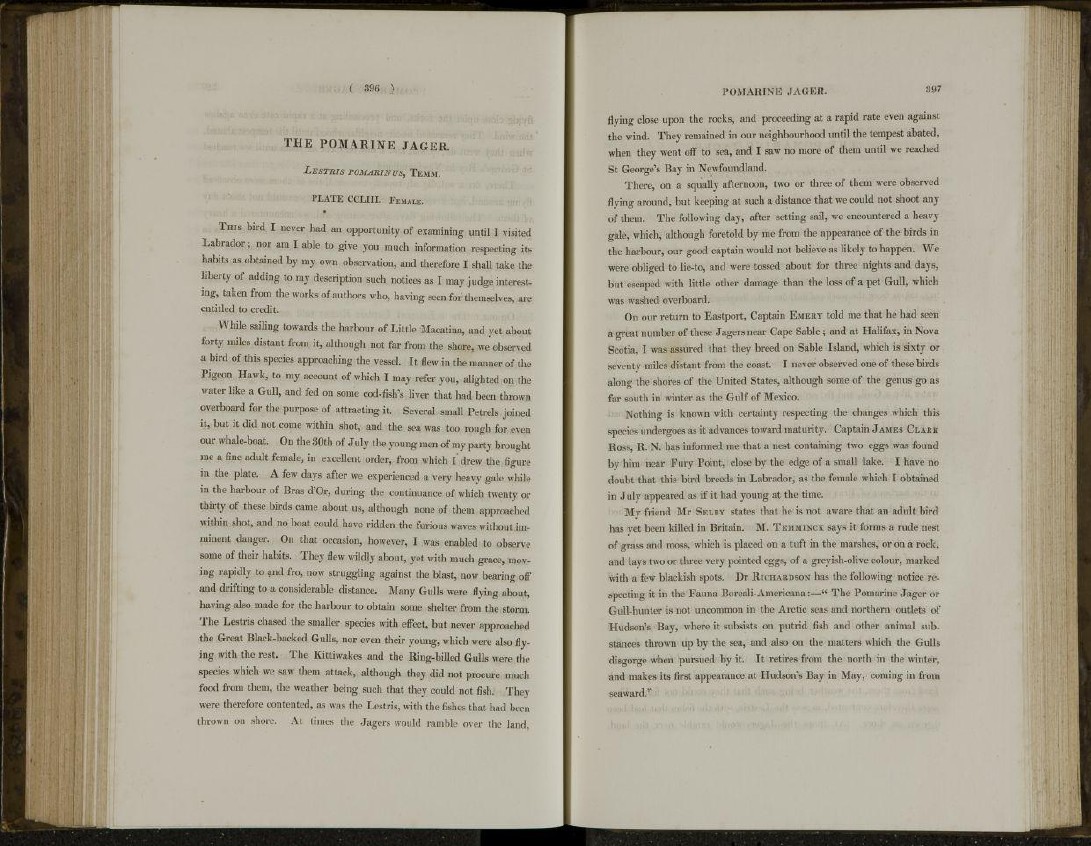
( 396 }
T H E P O M A R I N E J A G E R.
LESTRIS POMARINUS, TEMM.
PLATE CCLIII. FEMALE.
T H I S bird I never had an opportunity of examining until I visited
Labrador; nor am I able to give you much information respecting its
habits as obtained by my own observation, and therefore I shall take the
liberty of adding to my description such notices as I may judge interesting,
taken from the works of authors who, having seen for themselves, are
entitled to credit.
While sailing towards the harbour of Little Macatina, and yet about
forty miles distant from it, although not far from the shore, we observed
a bird of this species approaching the vessel. It flew in the manner of the
Pigeon Hawk, to my account of which I may refer you, alighted on the
water like a Gull, and fed on some cod-fish's liver that had been thrown
overboard for the purpose of attracting it. Several small Petrels joined
it, but it did not come within shot, and the sea was too rough for even
our whale-boat. On the 30th of July the young men of my party brought
me a fine adult female, in excellent order, from which I drew the figure
in the plate. A few days after we experienced a very heavy gale while
in the harbour of Bras d'Or, during the continuance of which twenty or
thirty of these birds came about us, although none of them approached
within shot, and no boat could have ridden the furious waves without imminent
danger. On that occasion, however, I was enabled to observe
some of their habits. They flew wildly about, yet with much grace, moving
rapidly to and fro, now struggling against the blast, now bearing off
and drifting to a considerable distance. Many Gulls were flying about,
having also made for the harbour to obtain some shelter from the storm.
The Lestris chased the smaller species with effect, but never approached
the Great Black-backed Gulls, nor even their young, which were also flying
with the rest. The Kittiwakes and the Ring-billed Gulls were the
species which we saw them attack, although they did not procure much
food from them, the weather being such that they could not fish. They
were therefore contented, as was the Lestris, with the fishes that had been
thrown on shore. At times the Jagers would ramble over the land,
POMARINE JAGER. 397
flying close upon the rocks, and proceeding at a rapid rate even against
the wind. They remained in our neighbourhood until the tempest abated,
when they went off to sea, and I saw no more of them until we reached
St George's Bay in Newfoundland.
There, on a squally afternoon, two or three of them were observed
flying around, but keeping at such a distance that we could not shoot any
of them. The following day, after setting sail, we encountered a heavy
gale, which, although foretold by me from the appearance of the birds in
the harbour, our good captain would not believe as likely to happen. We
were obliged to lie-to, and were tossed about for three nights and days,
but escaped with little other damage than the loss of a pet Gull, which
was washed overboard.
On our return to Eastport, Captain EMERY told me that he had seen
a great number of these Jagers near Cape Sable ; and at Halifax, in Nova
Scotia, I was assured that they breed on Sable Island, which is sixty or
seventy miles distant from the coast. I never observed one of these birds
along the shores of the United States, although some of the genus go as
far south in winter as the Gulf of Mexico.
Nothing is known with certainty respecting the changes which this
species undergoes as it advances toward maturity. Captain JAMES CLARK
Ross, R. N. has informed me that a nest containing two eggs was found
by him near Fury Point, close by the edge of a small lake. I have no
doubt that this bird breeds in Labrador, as the female which I obtained
in July appeared as if it had young at the time.
My friend Mr SELBY states that he is not aware that an adult bird
has yet been killed in Britain. M. TEMMINCK says it forms a rude nest
of grass and moss, which is placed on a tuft in the marshes, or on a rock,
and lays two or three very pointed eggs, of a greyish-olive colour, marked
with a few blackish spots. Dr RICHARDSON has the following notice respecting
it in the Fauna Boreali-Americana:—" The Pomarine Jager or
Gull-hunter is not uncommon in the Arctic seas and northern outlets of
Hudson's Bay, where it subsists on putrid fish and other animal substances
thrown up by the sea, and also on the matters which the Gulls
disgorge when pursued by it. It retires from the north in the winter,
and makes its first appearance at Hudson's Bay in May, coming in from
seaward."